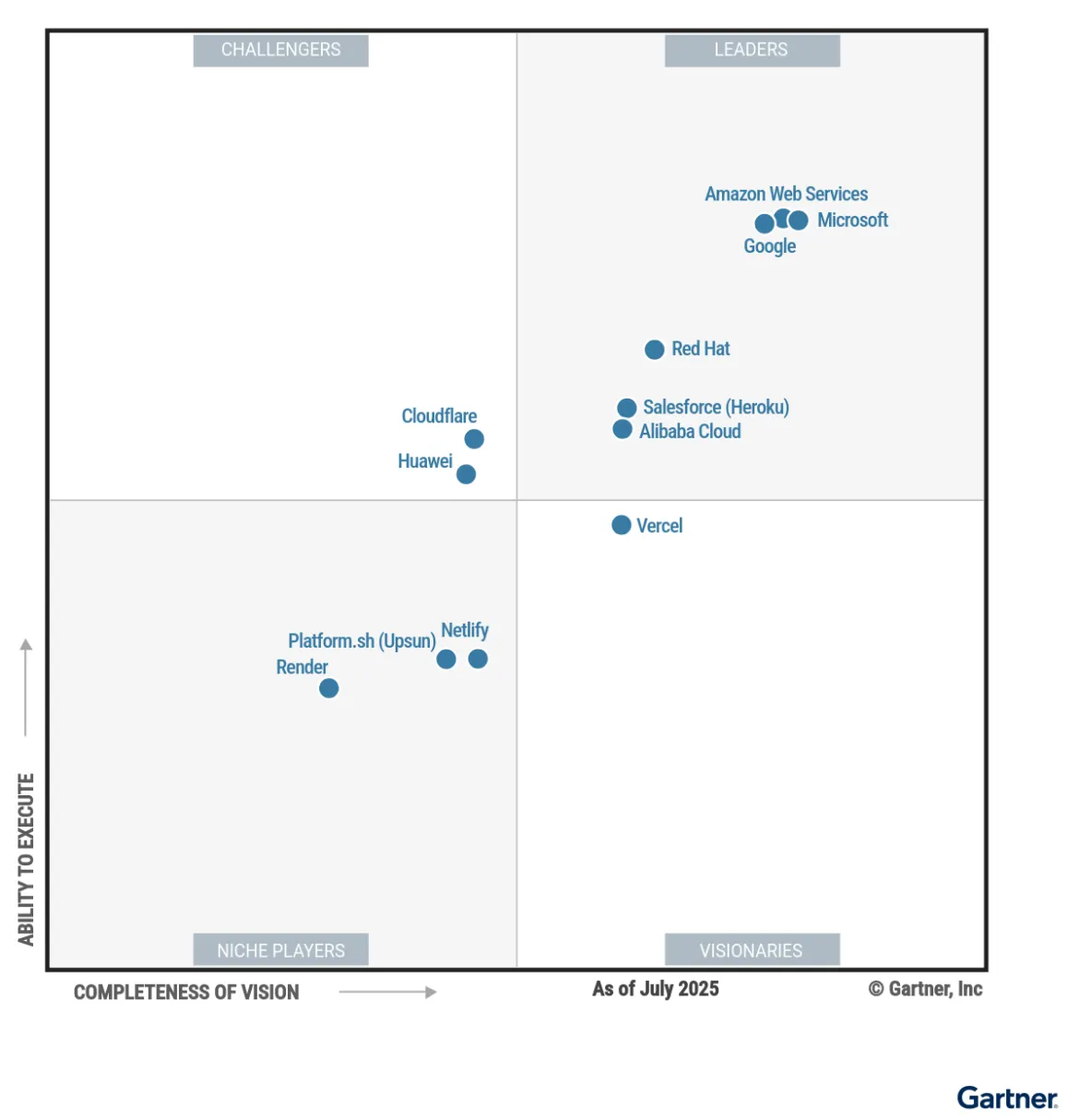This week we announced that Red Hat has been positioned as a Leader for the second year in a row in the 2025 Gartner® Magic Quadrant™ for Cloud-Native Application Platforms. We are proud of this recognition, as we believe this is a strong validation of Red Hat OpenShift cloud services as a flexible, complete, and secure cloud-native application platform for AI-enabled applications and virtualized and containerized workloads across the hybrid cloud. The Red Hat OpenShift cloud services portfolio consists of jointly engineered solutions with hyperscalers, including Red Hat OpenShift Service on AWS, Azure Red Hat OpenShift, Red Hat OpenShift on IBM Cloud and Red Hat OpenShift Dedicated on Google Cloud.

Source: Gartner, “Magic Quadrant for Cloud-Native Application Platforms,” August 2025
To help further explain the evaluation of the Gartner Magic Quadrant from our point of view, we’re answering some of the most frequently asked questions.
What is the Gartner Magic Quadrant?
“Magic Quadrant reports are a culmination of rigorous, fact-based research in specific markets, providing a wide-angle view of the relative positions of the providers in markets where growth is high and provider differentiation is distinct. Providers are positioned into four quadrants: Leaders, Challengers, Visionaries and Niche Players. The research enables you to get the most from market analysis in alignment with your unique business and technology needs.”
How was the evaluation done in this Magic Quadrant? What was the criteria for inclusion?
“Gartner defines cloud-native application platforms as those that provide managed application runtime environments for applications and integrated capabilities to manage the life cycle of an application or application component. They typically enable distributed application deployments and support cloud style operations — such as elasticity, multitenancy and self-service — without requiring the development team to provision infrastructure or manage containers.
Cloud-native application platforms are designed to facilitate the deployment, runtime execution, and management of modern cloud-native or cloud-optimized applications without the need to manage any underlying infrastructure. Also, they are designed to enhance developer productivity, accelerate development and deployment cycles, and increase operational effectiveness by making it easier to scale on demand.
Cloud-native application platforms offer a structured execution environment for applications, effectively hiding the complexities of the underlying infrastructure and computing resources. They also provide vendor-supported versions of application runtimes and frameworks for the commonly used languages (for example, Java, .NET, Node.js, PHP, Python, Go and Ruby). By abstracting the complexities associated with infrastructure management, cloud-native application platforms enable product teams to deliver faster customer value.
The cloud-native application platforms market reflects the consolidation of technologies across deployment, scalability, security and application observability to streamline software delivery. They are intended to be more than just a platform for running applications; they are essential for businesses aiming to achieve excellence in software engineering, productivity and market responsiveness.”
The mandatory features for this market include:
- Application runtime services (including language runtime support) for multiple application types including web applications, mobile back ends, microservices, AI/ML models and analytics applications without requiring infrastructure provisioning or creating and maintaining custom container images.
- Automated deployment of cloud-native applications (e.g., integration with DevOps).
- Autoscaling (load balancing, scalability and running of multiple instances).
- Application monitoring and observability — support for monitoring and observability to improve service-level objectives, gathering production telemetry (logs, metrics, events, traces).
- Fully managed service — Vendor (service provider) handles the maintenance, monitoring, updates and troubleshooting of the cloud-native application platform. This includes support, security, backups and performance optimization. It allows users to focus only on the application that can be deployed on cloud-native application platforms.
Why is this significant to us?
According to Gartner, Leaders execute well against their current vision and are well positioned for tomorrow. Gartner is one of the most recognized technology analyst firms in the IT space and we feel having been recognized as a Leader validates not only the current capabilities of Red Hat OpenShift, but also Red Hat’s vision for evolving the solution to best meet the needs of our customers in the future.
Learn more about Red Hat OpenShift as a Cloud-Native Application Platform
A full copy of the Gartner Magic Quadrant for Cloud-Native Application Platforms can be downloaded here.
Gartner disclaimer:
Gartner, Magic Quadrant for Cloud-Native Application Platforms, August 2025.
Gartner does not endorse any vendor, product or service depicted in its research publications, and does not advise technology users to select only those vendors with the highest ratings or other designation. Gartner research publications consist of the opinions of Gartner’s research organization and should not be construed as statements of fact. Gartner disclaims all warranties, expressed or implied, with respect to this research, including any warranties of merchantability or fitness for a particular purpose.
GARTNER is a registered trademark and service mark of Gartner and Magic Quadrant is a registered trademark of Gartner, Inc. and/or its affiliates in the U.S. and internationally and are used herein with permission. All rights reserved.
This graphic was published by Gartner, Inc. as part of a larger research document and should be evaluated in the context of the entire document. The Gartner document is available upon request from Red Hat.
product trial
Red Hat OpenShift Container Platform | 제품 체험판
저자 소개
Alexa Overbay is a Product Marketing Manager at Red Hat, focused on the marketing and positioning the Red Hat OpenShift Managed Services portfolio.
Anes Kim is a product marketing manager for Red Hat OpenShift cloud services and has been at Red Hat since 2020.
채널별 검색
오토메이션
기술, 팀, 인프라를 위한 IT 자동화 최신 동향
인공지능
고객이 어디서나 AI 워크로드를 실행할 수 있도록 지원하는 플랫폼 업데이트
오픈 하이브리드 클라우드
하이브리드 클라우드로 더욱 유연한 미래를 구축하는 방법을 알아보세요
보안
환경과 기술 전반에 걸쳐 리스크를 감소하는 방법에 대한 최신 정보
엣지 컴퓨팅
엣지에서의 운영을 단순화하는 플랫폼 업데이트
인프라
세계적으로 인정받은 기업용 Linux 플랫폼에 대한 최신 정보
애플리케이션
복잡한 애플리케이션에 대한 솔루션 더 보기
가상화
온프레미스와 클라우드 환경에서 워크로드를 유연하게 운영하기 위한 엔터프라이즈 가상화의 미래

